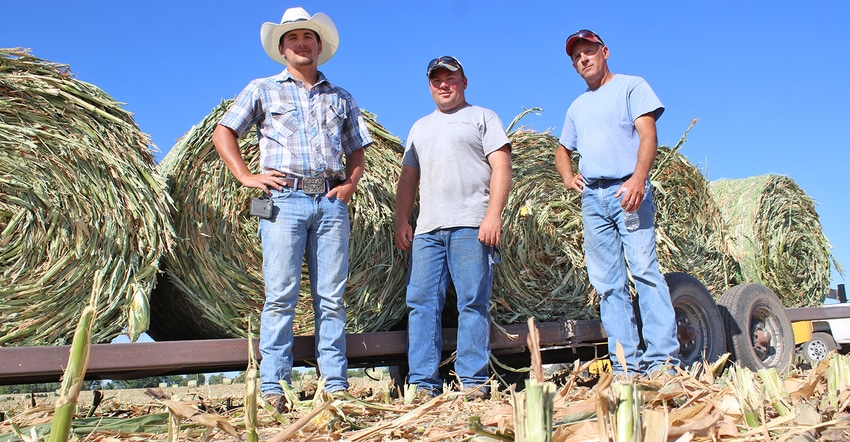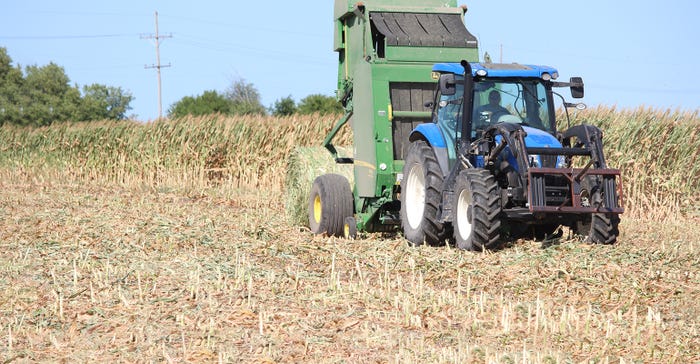August 9, 2018

Editor’s note: This is the second in a four-part series looking at how the 2018 drought affected farmers, ranchers and agribusinesses in northern Missouri. This area of the state has been hit the hardest by dry, hot conditions.
By Mindy Ward
A large round bale rests on the skid-steer spikes as John Graham maneuvers it around the tractor, where his son Caleb is pulling a baler, and toward his other son, Jacob, who waits at the flatbed trailer. As daylight wanes, the Graham family pushes hard to get the last bale off the field. They need every last one to fill a cattle feed shortage brought on by the 2018 drought. However, this is not hay. It is corn.
“We made the decision to start baling, because we knew the corn was going to yield poorly and we need to stock pile as much feed as we can,” John says. “We are just not sure how long this drought is going to last.”
This is the first time the family has ever baled corn. John laughs when he thinks about how he is going to feed it: “We’re not sure yet.” Still, the Caldwell County, Mo., cattle producer says it is better than leaving viable forage in the field.

CORN YIELD: The 2018 drought is turning out small corn ears. Some farmers are not waiting until harvest, instead trying to get the most out of the crop by baling it or cutting it for silage for cattle.

Graham farms just outside of the small town of Hamilton, in northwest Missouri. Like other cattle producers in this area, the family relies on grazing for feed in the early spring, summer and early fall. Granted pastures in the end of July often run short — but not this short.
According to the USDA National Agricultural Statistics Service, close to 70% of the state’s pastures were rated poor or very poor at the beginning of August.
“We waited for a green-up to happen,” John adds. “It just never did. The rain never fell.” They have not seen a sizeable rainfall since June.
Cornfields become source of feed
He and other livestock producers are looking for all the extra feed they can muster as the drought continues to linger. So they turn to cornfields.
This year, the corn progressed fast from early heat. “It was fully tasseled by the fourth of July,” John adds. “We knew at that point, we were in trouble.”

SUMMER SPECTACLE: Caldwell County, Mo., farmer John Graham say people have been driving by taking pictures or stopping to ask what the family is doing. It is not often corn is baled in July in northern Missouri.

Just two weeks later, the father-and-sons team was in the field baling. “We are just trying to salvage what is here and try to get at least some type of feed out of it,” Caleb says. On just these 18 acres alone, he will put up 126 corn bales. They will be wrapped in plastic within 24 hours to retain nutrients. The family also called in a custom chopper to put up other cornfields for silage, and the Grahams anticipate 12 tons per acre.
For John, the 2018 drought is worse than the one six years ago. “It came earlier and lasted longer,” he says. However, this time he not only has crop insurance for his corn, but also forage.
The USDA Risk Management Agency Rainfall Index insurance plan covers pasture, rangeland and forage grown for livestock grazing or haying. The RI PRF is an area-based insurance plan that uses a rainfall index to determine losses and trigger indemnities. “That will help,” John says.
Still, the cattleman likes to rely on his own efforts.
He still hopes to sow cover crops this year to provide additional forage. “But I will not attempt that until I see some moisture,” John says. A few good rain showers would go a long way.
With no sign of rain in sight, the Grahams walk back to their machinery. They have a lot more corn to bale before the sun sets.
You May Also Like




